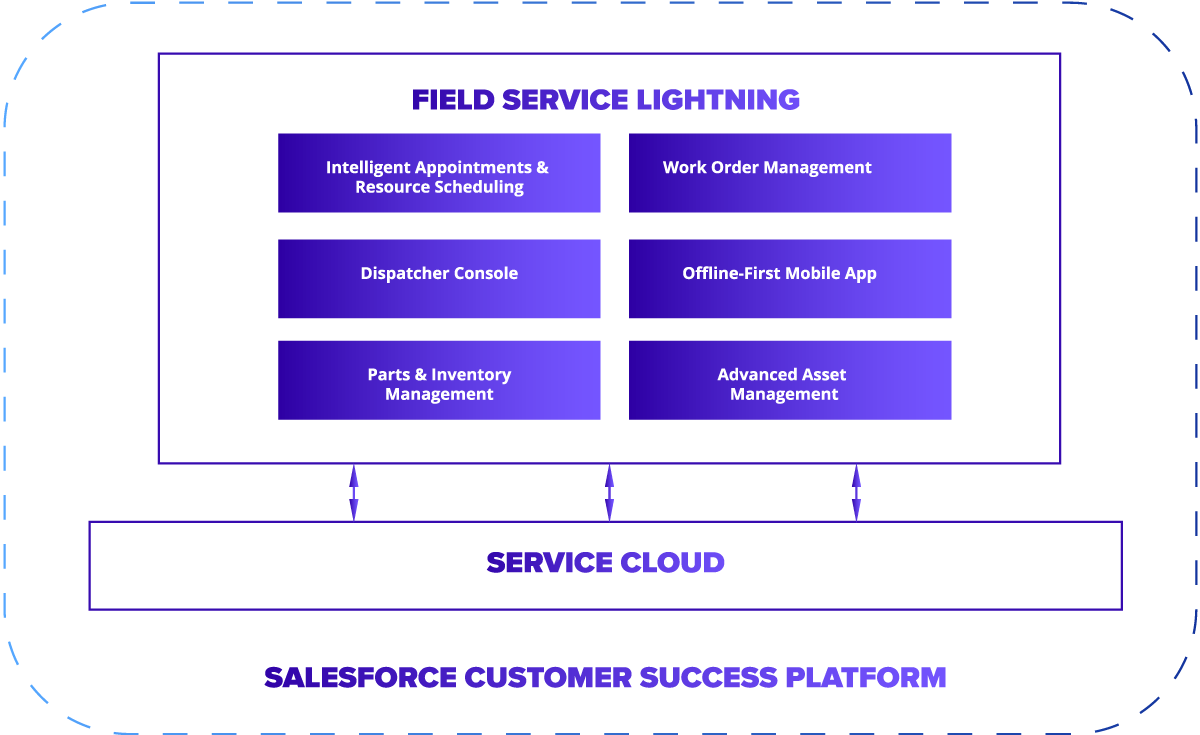Modernized field service is an essential competitive differentiator, and 82% of service decision makers say their company’s customer service must transform in order to stay competitive. Yet, disconnected systems and outdated practices often make it difficult to deliver excellent customer service for field workers.
By 2022, 70% of customer interactions will involve an emerging technology (such as machine learning or chatbots). Despite this trend, only 30% of field service providers will be ready to implement AI-based functionality to support field service management platforms and achieve competitive differentiation.
In addition to implementation readiness, companies will also need to establish effective customer data management for a 360-degree view of customers, across multiple channels.

The Field Service Imperative
To achieve great results in a new generation of service management, all employees involved in the service delivery process should be equipped with modern and functional tools enabling them to collaborate effectively. Service agents, dispatchers, and field workers should be provided with an in-depth view of each customer and case to achieve the desired outcome—whether a simple inspection or execution of a complex technical task is required.
To achieve the highest efficiency, while meeting growing customer demand—field service modernization is required.
The ideal field service flow is:
- Customer books a service appointment ⇨
- Service agent receives a request from client, creates a work order and service appointment ⇨
- Dispatcher assumes work order and assigns it to the right service technician based on schedules, technician expertise, and location ⇨
- Field service technician executes the work order by providing technical service or maintenance support at customer location
Hard Reality
The field service industry faces unique challenges and suffers from outdated practices with 52% of companies still using manual methodologies. Using these legacy processes, service providers have no unified view of customers, little visibility into mobile employee workload and schedules, and challenges with parts availability.
Successful service organisations are streamlined and agile with proactive and collaborative environments. Teammates share interdependent tasks, executed at full speed, with each team passing the baton to the next.

Gap Analysis
Contact centers are at the front line of customer service but experience difficulties with identifying channels to focused on, and which technologies are best to implement. Dependence on emerging technology is driving customer demand for faster and smarter service across all channels.
Nearly 70% of Gen X and Millennial customers use voice-activated personal assistants like Siri and Alexa to connect with companies, and on average, customers may use any one of 10 different channels to request service.
Common Service Gaps:
- Lack of innovation
- Poor resource allocation
- High costs/Low transparency and governance
- Service silos
Dispatch must ensure optimal: asset utilization, routing, field trip scheduling, authorized usage of company resources, and more. Even small errors can dramatically reduce service levels. Additionally, dispatchers must serve as liaisons between customers and field operators to ensure that issues are addressed quickly.
Common Dispatch Gaps:
- Low customer satisfaction, high friction / poor customer experience
- Missed or late arrival for appointments
- No singular view of customer
Field Operators are the face of the company and must ensure superior customer experiences to improve satisfaction, competitive differentiation, and ultimately earn brand advocacy which leads to word-of-mouth referrals.
One of the most powerful metrics to improve is first-time fix rate. Aberdeen Group reports that “Best-in-Class” field service companies resolve issues on the first visit 80% of the time, average companies 75% of the time, and laggards only 61% of the time. Even a 5% improvement elevates a company from average to outstanding.
Common Field Gaps:
- Low field tech productivity and efficiency
- Disparate and/or manual operations
- High operational costs
- Low field tech morale
Lightning Strikes
SoftServe delivers vital modernization through our expert implementation of Field Service Lightning (FSL) as part of Salesforce Service Cloud suite. FSL enables companies to transform every customer interaction and optimize end-to-end service operations. In fact, Nucleus Research states that FSL integration—with other Salesforce Clouds and the broader ecosystem—is a key reason for selecting Salesforce.

CONCLUSION
Field Service Lightning improves operational efficiency, customer satisfaction, and revenue growth – but simply investing in technology is not enough to ensure KPI achievement. Having the right process advisor and implementation partner is often a prerequisite to ensuring optimal gains as well as interoperability with other systems.
Let’s talk about where you are in your FSL journey and how SoftServe and Salesforce FSL provide best tools available to serve and execute faster and dynamically compete in today’s digital economy. Download whitepaper in which leaders from our CoE review the features and benefits of Salesforce FSL and how it can enable business operations.

